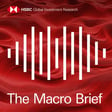Become a Creator today!Start creating today - Share your story with the world!
Start for free
00:00:00
00:00:01

The New Normal: Adopting emerging technologies in the current pandemic and beyond – Part 2
In response to the pandemic, businesses around the world have been forced to accelerate the adoption of emerging technologies to mitigate its impact. HSBC hosted a virtual roundtable with business leaders in October 2020 to understand how companies are embracing emerging technologies to stay relevant in a post-COVID-19 world. Hear from Joseph Chua, Executive Director, Treasury, Lenovo on how the company has woven automation into its treasury workflow and how they have overcame challenges.
For more information about anything that you have heard in this podcast, please visit grp.hsbc/tnn
Hosted on Acast. See acast.com/privacy for more information.
Transcript
Introduction to HSBC Global Viewpoint Podcast
00:00:01
Speaker
This is HSBC Global Viewpoint, your window into the thinking, trends and issues shaping global banking and markets.
00:00:10
Speaker
Join us as we hear from industry leaders and HSBC experts on the latest insights and opportunities for your business.
00:00:18
Speaker
A heads up to our listeners that this episode has been recorded remotely, therefore the sound quality may vary.
00:00:25
Speaker
Thank you for listening.
00:00:29
Speaker
Thank you for joining us today.
Adopting Emerging Technologies During the Pandemic
00:00:32
Speaker
Welcome to the new normal, adopting emerging technologies in the current pandemic and beyond webinar.
00:00:38
Speaker
The agenda for today's discussion moderated by David Koh, Head of Global Liquidity and Cash Management, HSBC Singapore, with our esteemed panelists today, Joseph Chua, Lenovo's Executive Director
Lenovo's Shift to Automated Financial Workflows
00:00:51
Speaker
at Treasury.
00:00:51
Speaker
And coming to you, Joseph, perhaps some experience sharing for Lenovo,
00:00:58
Speaker
How have you guys adopted technology for your treasury and finance workflows?
00:01:03
Speaker
Well, for us, we have been trying to automate or to depend as much as possible over the internet.
00:01:11
Speaker
So take, for example, we have been using internet banking for a very long time and we can't
00:01:19
Speaker
Recently, because of the COVID situations, looked towards automating even the internet banking through APIs between, let's say, our SAP, which is the ERP system that we use to actually connect from our SAP to produce the API for the payment through our internet banking platform.
00:01:40
Speaker
So in addition to that, some of the experiences that we had was that in the past, we had to have wet signatures and
00:01:47
Speaker
You know, banks love to have wet signatures and even weakness and so on.
00:01:52
Speaker
With the COVID lockdown, something that we can't execute.
00:01:56
Speaker
So we actually push along the line to have electronic signatures being accepted.
00:02:01
Speaker
And today, I think within, say, Singapore, Hong Kong, or even the Asia region, it is pretty well accepted.
00:02:11
Speaker
And it was very surprising a couple of weeks ago that we actually had a bank in India that accepted on digital signatures.
00:02:19
Speaker
Of course, they still insist followed by the original, which is fine.
00:02:23
Speaker
At least we can get transaction going on.
00:02:26
Speaker
So our push has been always to go electronic.
00:02:29
Speaker
And one of our initiative, which coincidentally we tried to do it before COVID was to build an electronic platform to bring
00:02:40
Speaker
both AR and AP into a platform where the banks will come in and do, let's say, receivable purchase from the lease of assets that we lease in the platform and for them to look at payments where they want to look at supply chain financing.
00:02:56
Speaker
So we're going to be open up to that, to all the banks and see what they like to do.
00:03:01
Speaker
And with that electronic platform, it just cuts away all the manual and paperwork associated with it.
00:03:09
Speaker
Wow, great, Joseph.
00:03:11
Speaker
Sounds like you guys have made a lot of progress
Enhancing Liquidity Management with AI and Data Mining
00:03:13
Speaker
there.
00:03:13
Speaker
How are treasurers like yourself leveraging data or any sort of form of automation and AI to make better decisions around cash flow and just running a better business?
00:03:24
Speaker
Yeah, I mean, we gave up trying to forecast in interest rates or FX rates anyway.
00:03:29
Speaker
So we leave that to the professional, which are the bankers.
00:03:34
Speaker
So what we do is really very much to the basic, and that is to say,
00:03:39
Speaker
how do we forecast more accurately?
00:03:42
Speaker
And everybody talks about big data, data mining, you know, AI and so on.
00:03:46
Speaker
So the basic stuff is to say, okay, how do I get my cash flow forecast accurately?
00:03:51
Speaker
Because that is key.
00:03:53
Speaker
That is key to the liquidity and the whole working capital cycle.
00:03:56
Speaker
And even, you know, you identify and say that you do need longer term capital or let's say capital market debt.
00:04:04
Speaker
instruments like bonds and so on.
00:04:06
Speaker
So we started a process to look through years of data and pulling it.
00:04:12
Speaker
You don't need a lot of architects, but you need to have the analysts that understand, you know, this data and how do they pull them together and, you know, we build a certain logic that you are going to use it to predict or to forecast what would be, let's say, for example, for the next one, two years, what would be the cash flow?
00:04:32
Speaker
And of course, you need the input as to the business growth or, you know, a pessimistic view, an optimistic view and so on.
00:04:39
Speaker
Whatever view that we want, it will lead to that.
00:04:43
Speaker
And we actually mine the data to say that, you know, if you have a billion of revenue, you know, if let's say, for example, you have a net margin of 20%, what will be the cost, the expenses, the payment out and so on.
00:04:56
Speaker
So we are drilling this.
00:04:58
Speaker
And one of the things that we discovered was that
00:05:02
Speaker
when pulling the data out of bank statements, actually the bank statements that you receive today doesn't have sufficient information.
00:05:10
Speaker
You need more detailed information on, let's say for example, invoice level
00:05:17
Speaker
So that when you do forecast, you know this particular supply and for what type of invoices and what type of expenses, which will give you better results.
00:05:28
Speaker
You know, of course, today, if you have a high level, you can say, okay, you know, I'm going to pay our expenses and my payment run are weekly.
00:05:35
Speaker
And it gives you a certain degree of reliability.
00:05:38
Speaker
But we are actually trying to go into a daily cash forecast and not a monthly.
00:05:44
Speaker
In the past, I think most companies would go on a quarterly because that's when their quarterly results in ending balances.
00:05:51
Speaker
But we thought that we should be looking at
00:05:54
Speaker
daily forecast where we can minimize or maximize liquidity so that we can maximize interest returns, which unfortunately today is pretty much almost zero interest that you receive.
00:06:07
Speaker
But for borrowing, so if you are, let's say for example, using some sort of short-term borrowing,
00:06:13
Speaker
daily forecasting will help you predict your cash requirement and therefore minimize on interest expense.
00:06:20
Speaker
And that is something that, you know, we have not perfected, but we are still working on it.
Challenges in Digitalization at Lenovo
00:06:25
Speaker
And it might take maybe at least another six months before we have our first version to test out, to see how effective that is.
00:06:33
Speaker
So Joseph, what are the challenges you face when you embark on your own digitalization journey?
00:06:39
Speaker
Well, I think first of all, you know,
00:06:41
Speaker
people will view that their job scope is challenged.
00:06:47
Speaker
So the first thing that you need to do is to convince them that this is going to improve their workflow, be more efficient, because this is very key because they help you to build the logic in an automation or into an electronic process.
00:07:05
Speaker
If the working level are not going to give you that kind of working logic and support, you will find that later on when you go live, you will experience a number of issues that you need to rectify.
00:07:18
Speaker
rather than wait until then which of course you can do it but you know you want it to go live and everything good smooth so cooperation and clear understanding of all the people involved including bringing our IT people because a lot of these we we have our IT people other than you know get our third party suppliers to get them to understand the business flow and build the logic so once everybody understands they get
00:07:45
Speaker
to get to the logic and the workflow, then you'll find that it does move slowly.
00:07:52
Speaker
And of course, the other part is to convince our top management that the money that is spent is worth it.
00:07:57
Speaker
So obviously you have to prove the point that with this automation, you're gonna save a lot of efficiency and work.
00:08:03
Speaker
I'm gonna have a challenge there, I'm sure.
00:08:06
Speaker
Thanks, Joseph.
00:08:12
Speaker
Thank you for listening today.
00:08:14
Speaker
This has been HSBC Global Viewpoint, Banking and Markets.
00:08:18
Speaker
For more information about anything you heard in this podcast or to learn about HSBC's global services and offerings, please visit gbm.hsbc.com.

















